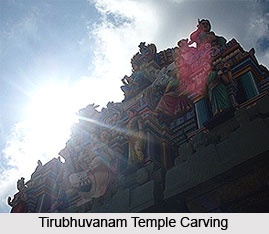 Tirubhuvanam is a small town in Tamil Nadu, which is located approximately 7 km from Kumbakonam. It is also known as Tribhuvanam and is a very crowded place. Earlier, Tirubhuvanam was part of the large city of Kumbakonam.
Tirubhuvanam is a small town in Tamil Nadu, which is located approximately 7 km from Kumbakonam. It is also known as Tribhuvanam and is a very crowded place. Earlier, Tirubhuvanam was part of the large city of Kumbakonam.
Now, Tirubhuvanam has large number of silk-weaving units and textile shops. The soft and lustrous Tirubhuvanam silk sarees are regarded to be a prized possession by many young brides of the area. The magnificent Kampahareshvara temple has made the place very popular. Kulottunga III, one of the last Chola rulers constructed this temple in the beginning of the 13th century AD. This temple is the last of the four great temples built by the Chola kingdom. The other three are the big temples at Tanjavur, Gangaikondacholapuram and Darasuram. It is also the last of the numerous temples built by Kulottunga III.
There is a captivating story behind the creation of the Tirubhuvanam temple here. Kulottunga fought three wars against the Pandyas who ruled from Madurai, south of the Chola kingdom. He won the third war, Kulottunga hosted a grand party for his friends in Madurai. He pompously assumed the title Tribhuvutm Vira Devar or `the bold ruler of the three worlds` at this party. The Tirubhuvanam temple was thus constructed to commemorate Kulottunga`s victory over the Pandyas.
As per another story, once a Chola prince was suffering from a strange disease because of the curse of Shani Bhagavan (Saturn). The sad prince prayed for his health in the temples of Tiruvidaimarudur, a sacred town near Tirubhuvanam. From Tiruvidaimarudur, the prince walked up to Tirubhuvanani. When he reached the place where the Kampahareshvara temple stands now, he was cured of his disease. Hence, Kulottunga erected this temple at this holy spot.
There are two gopurams or entrance towers through which one can enter the temple. The outer tower has five tiers and the inner one has three. The tower above the square sanctum of the central shrine of the temple is six-storied. The Archaeological Department has not protected the Tirubhuvanam temple. The walls and towers of this temple are painted in gaudy colours. The shrine dedicated to Lord Sarabhamurti is the most important sub-shrine at the Tirubhuvanam temple. There is a mythological story related to this deity. It is known by all that Lord Vishnu once took the incarnation of Narasimha on this earth (half-lion, half-human being) to save his devotee Prahlad from his father, the demon king Hiranyakasipu. It is said that after the destruction of Hiranyakasipu Narasimha turned very ferocious. So, to get rid from his fury, men and women prayed to Lord Siva to find a solution of the situation. Hence, Siva assumed the form of Sarabhamurti, who had the body and face of a lion and a tail. He had four human hands that carried respectively, the axe, rope antelope and fire, which are usually held by God Siva.



















